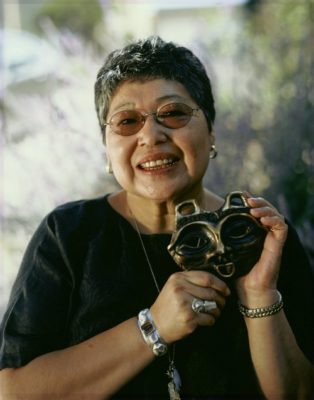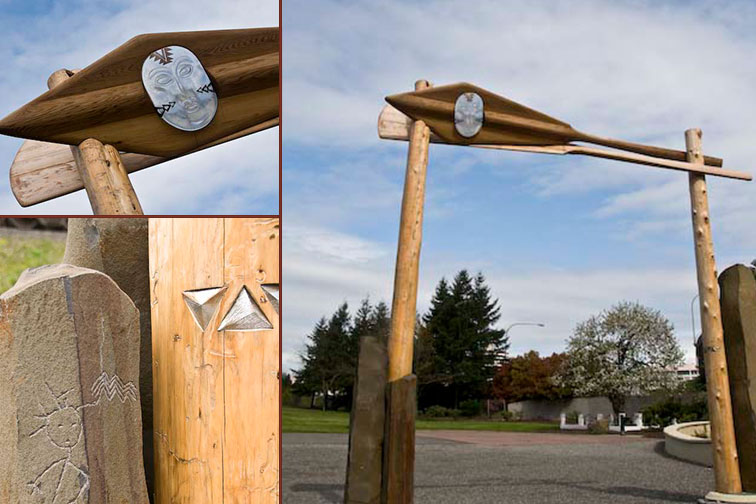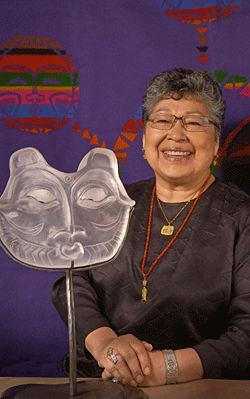
Stonington Gallery is honored to show a new body of work this May that springs from the vision of respected elder artist Lillian Pitt, in collaboration with Dan Friday (Lummi). Lillian has written and spoken extensively on her experiences as an indigenous artist and her journey to becoming the culture-bearer she is today. Learn more about Lillian in her own words below, and please join us in welcoming her for the opening reception on May 3rd, 6-8pm.
Lillian Pitt is a Pacific Northwest Native American artist, from the Wasco, Warm Springs and Yakama nations. She was born and raised on the Warm Springs reservation in Oregon. Her ancestors lived in and near the Columbia River Gorge for over 10,000 years. The Columbia River was called, simply, the Big River, or the Nch’i-Wana, by her ancestors. It was the backbone of one of the largest trade networks in all of Native America.
Lillian creates works of fine art that delight today’s art lovers, and at the same time, honor the history and legends of her people. She has accumulated a lifetime of works in a variety of media. Those media include artistic expressions in clay, bronze, wearable art, prints, glass, and jewelry. Her works are regularly exhibited throughout the Pacific Northwest, as well as nationally and internationally. Art by Lillian Pitt can be found in personal collections, art galleries, and museums. Her works are also displayed in numerous public spaces including parks, schools, and cultural institutions.
Lillian Pitt on Her Career and Background:
“I was in my 30’s, and already an artist before I knew that my ancestors lived in the Columbia River Gorge for more than 10,000 years. I had no idea. That’s 8,000 years before the time of Christ, and 6,000 years before the time of the Great Pyramids at Giza!
My family never spoke about it, because when I was growing up, it was better for our survival to try and cover up the fact that we were Indian. But today I can tell you that I’m proud of who I am and who my people are. We are Warm Springs, Wasco (Watalas) and Yakama (Wishxam) people — Indian people of the Pacific Northwest. We call ourselves the River People.
My early years as an artist involved learning about my heritage. We didn’t talk much about my ancestors when I was growing up, because my father thought I could have a better life if I wasn’t so Indian. So in my early years as an artist, I didn’t really know all that much about the traditional arts of my people. I wasn’t even all that sure as to whether or not I wanted to be an “Indian” artist or just an artist. But then an elder took me to see the rock carvings and paintings created thousands of years ago by my ancestors, and I was hooked. I couldn’t get over how interesting these rock images were.
So since those early years as an artist, I’ve spent a lot of time learning about my ancestors and studying the designs that they created. I learned everything I could about their rock carvings, their baskets, beaded bags, dresses, the tools they used. You name it, I’ve tried to learn about it all. But there’s so much. I don’t think I could ever learn about 10,000 years of history in just one lifetime.
Still, my goal is to incorporate as best I can, the traditional Native American arts of my ancestors into the contemporary art that I create. Regardless of the medium, and ever since my early years as an artist, my work directly relates to and honors my ancestors, the environment, and the animals.

My parents were both brought up at a time when Indian children were forced to go to Indian boarding schools, where the children were punished if they dared to speak in their native languages. That’s one way that they tried to strip our culture from us so that we would have no memory and no compass. And so my father grew to think that we would be better off if we tried to be less Indian. He felt that being less Indian could help his children have more comfortable lives.
It was a really terrible time. Indian children were forced to leave their homes and their families and were treated as if they were in the military. My mother and father both went to the Chemawa Indian School in Salem, Oregon. Remarkably, Chemawa is still open to this day. Fortunately, the school no longer forces children from their homes, and today, with the advantage of more insight and understanding, they’re now trying to help the people they serve regain their sense of identity. People attending the school today no longer want to be less Indian.
I remember a story my father told about when he was there as a small boy. He was forced, along with all the other boys, to wear a uniform and to march around with wooden guns. One time, he forgot to salute the Sargent while marching, and so as punishment, he had to salute every tree in the area. Little did the Sergeant know that it was actually a privilege to my father to be able to salute the trees as compared with having to salute the Sergeant.
So, while he encouraged his children to be less Indian, he himself was, in fact, true Indian at the core.
Being an Indian artist wasn’t necessarily a good thing in the early days. And, it’s not necessarily a good thing still to this day. There was, and still is, a lot of baggage to go along with it. And like most artists, I had some very lean years. There were many, many times when I truly did wonder if I was going to be able to pay the rent.

I date my start as an artist to 1981, when I first met R. C. Gorman at an art show in Portland. I wasn’t thinking of becoming an artist at the time, but I was taking an art class as a college elective when R. C. came to Portland. I went to see him on a whim, and I brought him some photos of masks that I had been working on as part of my class.
I was shocked when he said he wanted to buy two pieces! From that point on, I was hooked. I was now an artist. Other people, of course, helped me over the years, and I am grateful to everyone. But it was R.C. Gorman who actually gave me my initial start as an artist.
R.C. invited me to his home every year since then until he died in 2005. He was an amazing inspiration to me, and I’ll always be grateful to him for giving me the help and support I needed over all those years. Now I try to return the favor, by teaching as many people as I can about the things that I know, and by helping them along their own paths in whatever ways I can.
And after my 7th back operation, I thought I might not even be able to work as an artist anymore. It takes some strength you know to mold clay and to work with heavy materials like bronze and glass. But I’m still working … and still loving what I do.”
-Writing and Quotations Courtesy and Copyright of Lillian Pitt
